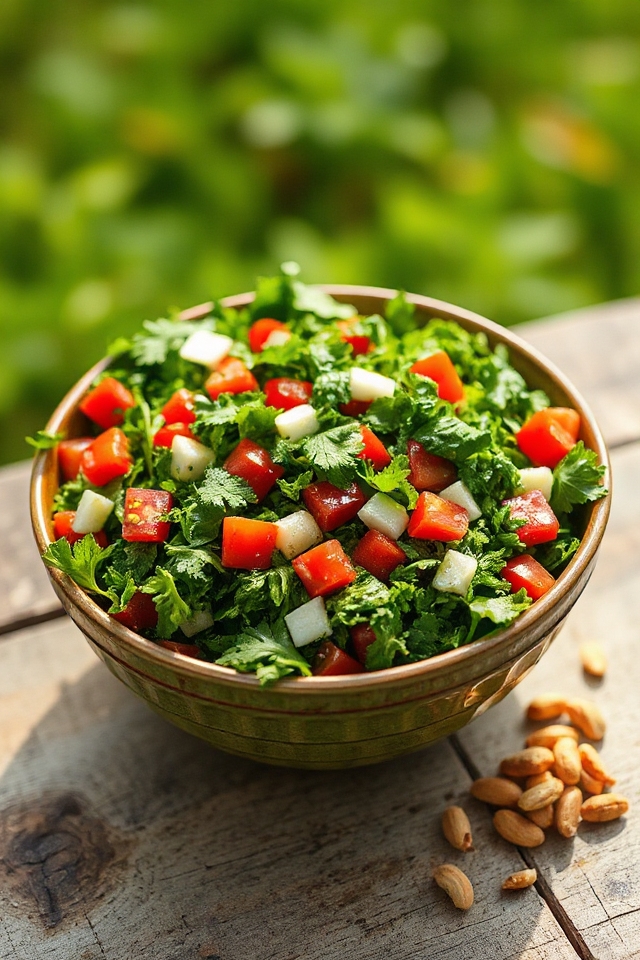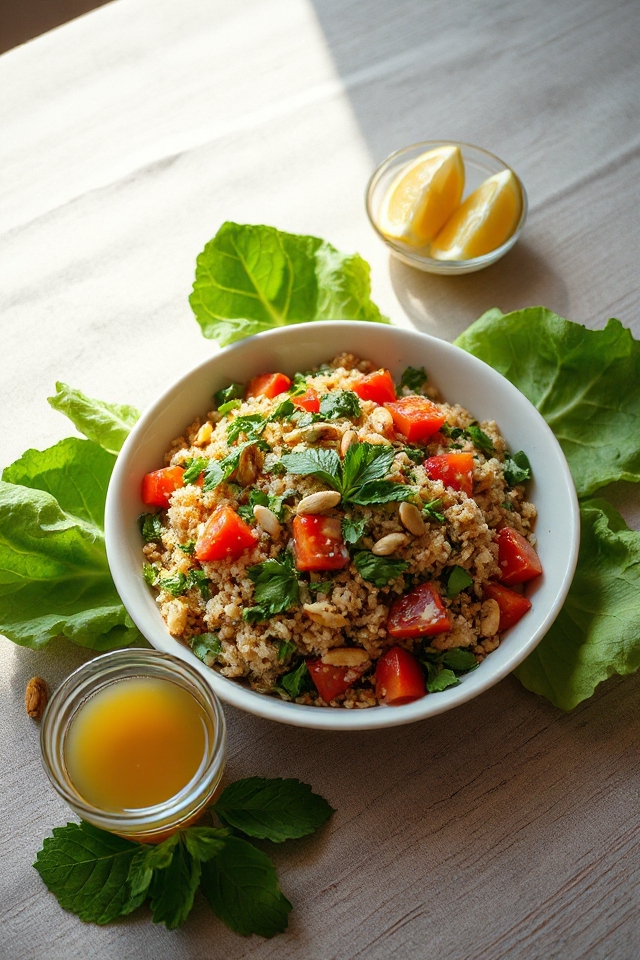Why You’ll Love this Tabbouleh Salad Recipe
There’s something incredibly revitalizing about a good tabbouleh salad. Each bite bursts with fresh flavors, making it a perfect dish for any occasion.
I love how the combination of herbs and grains creates a light yet satisfying meal. It’s not just delicious; it’s healthy, packed with nutrients that make me feel energized.
Preparing it’s a joy, too—chopping fresh parsley and mint fills the kitchen with an invigorating aroma. Plus, it’s versatile; I can serve it as a side or a main dish.
Trust me, once you try this recipe, you’ll be craving tabbouleh all summer long!
Ingredients of Tabbouleh Salad
When it comes to whipping up a fresh tabbouleh salad, the ingredients are key to capturing that vibrant flavor that makes your taste buds dance. This dish is all about celebrating the garden-fresh goodness of herbs, grains, and a drizzle of olive oil that ties everything together.
So, let’s plunge into what you’ll need to create this colorful and delicious salad. Gather these ingredients, and let’s get started on your culinary adventure!
Ingredients for Tabbouleh Salad:
- 2 cups water
- 1/2 teaspoon kosher salt, plus more as needed
- 1 cup medium-grind bulgur
- 1/2 cup extra virgin olive oil, plus an additional 2 teaspoons for toasting pine nuts
- 1/2 cup pine nuts
- Fresh ground black pepper
- 1 cup finely chopped Italian parsley (or about 2 bunches)
- 1/2 cup finely chopped fresh mint leaves (or about 1/2 bunch)
- 5 medium scallions (finely chopped, white and light green parts only)
- 4 medium roma tomatoes (seeded and diced) or about 3/4 cup of diced roma tomatoes
- 3 tablespoons fresh lemon juice (from about 2 medium lemons)
- 1 1/2 teaspoons ground sumac
- 1 medium head romaine lettuce (for serving)
Now that you have the ingredients ready, it’s essential to think about the freshness of your herbs and vegetables. Fresh parsley and mint are the backbone of this salad, so don’t skimp on quality.
If you can, visit your local farmer’s market or grocery store and pick out the freshest bunches. Trust me, it makes a world of difference.
Also, if you’re feeling adventurous, experimenting with different types of tomatoes can add another layer of flavor.
And as a side note, if you happen to drop a few pine nuts while toasting, just consider it a culinary adventure—who doesn’t enjoy a bit of kitchen chaos? Embrace it; that’s part of the fun!
How to Make Tabbouleh Salad

Making tabbouleh salad is like taking a culinary stroll through a garden, and it all starts with the bulgur. First, grab 2 cups of water and 1/2 teaspoon of kosher salt, and bring that to a boil in a medium saucepan. Once it’s bubbling away like a happy cauldron, stir in 1 cup of medium-grind bulgur.
Then, take it off the heat, cover it up tightly, and let it sit for about 15 minutes. You want that bulgur to soak up all that salty goodness and become tender. After the time’s up, drain any excess liquid using a fine-mesh strainer—don’t forget to press it a bit to squeeze out the moisture.
Once drained, plop the bulgur into a large bowl and let it cool down to room temperature because nobody wants a hot salad, right?
While the bulgur is cooling, let’s give those pine nuts some love. Heat up 2 teaspoons of extra virgin olive oil in a small frying pan over medium heat. Toss in 1/2 cup of pine nuts, season them with a sprinkle of salt and fresh ground black pepper, and stir occasionally.
Keep an eye on them, as they can go from golden brown to “Oh no, I burned them” in a heartbeat—trust me, I’ve been there. After about 3 to 5 minutes, when they’re beautifully toasted and smelling like heaven, take them off the heat and let them cool.
Now comes the fun part! In your bowl of cooled bulgur, mix in 1 cup of finely chopped Italian parsley, 1/2 cup of finely chopped fresh mint leaves, 5 finely chopped scallions (stick to the white and light green parts), and 4 medium roma tomatoes that have been seeded and diced.
It’s like a colorful garden party in your bowl. In a separate small bowl, whisk together 3 tablespoons of fresh lemon juice, 1/2 cup of olive oil, and 1 1/2 teaspoons of ground sumac. Pour that zesty dressing over the bulgur mixture and stir everything together gently.
Taste it, and if it needs a little more salt or pepper, go for it. Cover the salad and let it chill in the fridge for at least 15 minutes—this helps the flavors mingle and become best friends.
When you’re ready to serve, prepare your romaine lettuce by washing and drying the leaves, and then spoon the tabbouleh onto them. It’s fresh, vibrant, and oh so satisfying. Enjoy your garden in a bowl!
Tabbouleh Salad Substitutions & Variations
While traditional tabbouleh salad is a delightful blend of bulgur, fresh herbs, and vegetables, don’t hesitate to get creative with substitutions and variations to suit your taste.
I often swap bulgur for quinoa or couscous for a gluten-free option. If you’re not a fan of pine nuts, try walnuts or almonds instead.
For a zesty twist, add diced cucumbers or bell peppers. You can also experiment with different herbs; cilantro adds a unique flavor.
Finally, feel free to adjust the acidity by adding more lemon juice or vinegar. The possibilities are endless, so make it your own!
What to Serve with Tabbouleh Salad
Tabbouleh salad is a vibrant dish that pairs wonderfully with a variety of accompaniments.
I love serving it alongside grilled meats like chicken or lamb, as the fresh flavors complement the smoky grill perfectly. You can also enjoy it with warm pita bread or falafel for a satisfying vegetarian meal.
For something lighter, try it with a side of hummus or tzatziki. A revitalizing cucumber salad adds a nice crunch, too.
If you’re hosting a gathering, consider a mezze platter with olives and stuffed grape leaves to elevate the experience!
It’s all about balancing flavors and textures.
Additional Tips & Notes
Serving tabbouleh salad alongside grilled meats or warm pita bread enhances its fresh flavors, but there are a few additional tips to guarantee you get the most out of this dish.
First, always use fresh herbs; they make a huge difference. If you can, let the salad chill longer than 15 minutes to allow the flavors to meld beautifully.
Don’t skip the sumac—it adds a unique tang. For an extra crunch, consider adding diced cucumbers or bell peppers.
Finally, adjust the lemon juice and olive oil to suit your taste. Enjoy experimenting with variations to make it your own!
